How to Trim a Fig Tree the Right Way with Expert Tips
Have you ever wondered why your fig tree is not producing as much fruit as it should, or why it is growing more like a jungle than a healthy tree? You are not alone. Trimming fig trees might seem simple, but one wrong cut can set you back an entire season.
As we have already explained how to trim apple trees in our previous post, we are now moving further into the orchard with a dedicated guide on fig trees. Based on years of real-world experience working across Fremont, California, our certified pruning specialist, Ravi, is here to share professional insights on how to bring overgrown or underperforming fig trees back to life.
This is not just another generic tutorial. This post is filled with practical advice that comes from hands-on work with fig trees of all shapes and sizes. Keep reading to learn the best time to trim, the tools you will need, and step-by-step methods for pruning your fig tree the right way, so you can improve fruit production, maintain the tree’s health, and keep it looking great year after year.
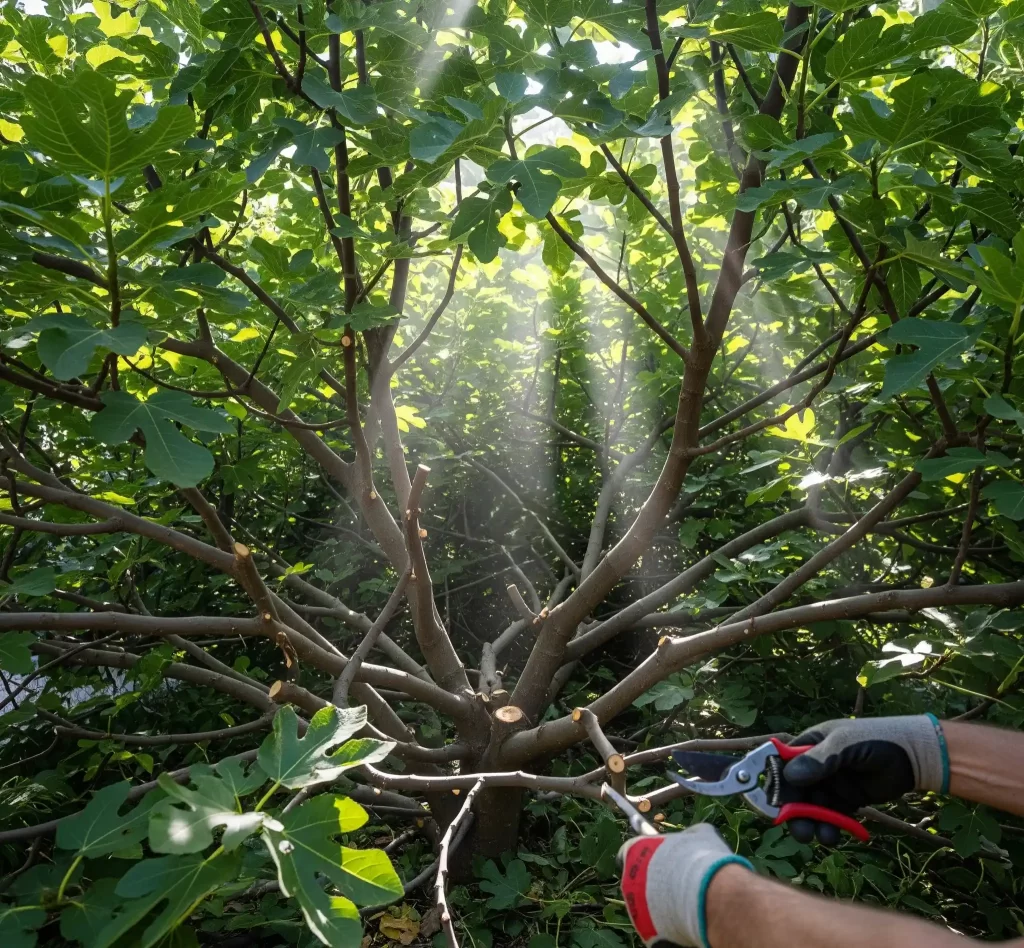
Why Pruning Your Fig Tree Matters
Fig trees are naturally vigorous growers. Without regular pruning, they can quickly become overgrown and unmanageable, with thick interior growth that blocks sunlight and restricts airflow. This dense structure invites pests, increases the risk of disease, and ultimately reduces your fig harvest.
Proper pruning, on the other hand, sets your tree up for long-term success. When done right, it helps your fig tree:
- Develop a strong, balanced, and open structure
- Allow sunlight to reach the inner branches
- Improve airflow to reduce disease risk
- Produce larger, sweeter, and more consistent fruit
- Stay healthier and live longer
- Become easier to harvest and maintain
I have trimmed dozens of fig trees in backyards across Fremont, and I can confidently say this: intentional pruning each year makes all the difference. A few thoughtful cuts now can reward you with a beautiful, productive tree for years to come.
Best Time to Trim a Fig Tree
We have already covered the best time to trim trees in one of our earlier posts, along with a visual calendar that shows which months are ideal for pruning various fruit trees, including Apple and fig trees. If you are new to seasonal pruning or juggling multiple types of fruit trees in your yard, be sure to check out our fruit tree pruning guide for a full breakdown.
That post explains why late winter to early spring is the safest and most effective time to prune, along with tips to help you avoid common seasonal mistakes. Instead of repeating all that here, let us move forward and focus on the specific approach you need when trimming a fig tree.
Tools You’ll Need (Don’t Skimp on Quality)
We have already covered the best tools in our Tree Trimming Tools Guide, including detailed explanations of what to use and when. However, generally, when planning to prune a fig tree, you will need bypass hand pruners, loppers, a pruning saw, rubbing alcohol or bleach, gardening gloves, and eye protection. Using the right tools makes the job safer, faster, and cleaner, especially for a tree like the fig, which can grow quickly and develop thick limbs if left unchecked.
4 Key Steps to Prune a Fig Tree Properly
As we covered in our general tree trimming guide and fruit tree pruning steps, the core process, sanitizing tools, removing dead/diseased wood, and thinning the canopy, is the same across most fruit trees.
But when it comes to fig trees, there are a few specific techniques and shaping principles I follow on every job:
1. Focus on an Open Canopy
Figs love light and airflow. Open up the center so sunlight reaches deep into the canopy.
- Remove inward-growing branches toward the trunk
- Remove crossing limbs that rub
- Remove overcrowded vertical shoots
💡 Test it visually: Toss a baseball through the middle — if it passes cleanly, you’re good.
2. Shape Gradually for Long-Term Health
Avoid over-pruning in one season. Aim for an open vase shape over 2–3 years.
- 3–5 main scaffold branches angling outward
- No central leader — figs grow wide naturally
- Evenly spread fruiting branches
✂️ Cut above an outward-facing bud to guide growth.
3. Keep Fruit Within Reach
Prune so fruit can be harvested by hand. Shorten long, leggy branches.
Encourages bushier side growth where fruit forms more easily.
4. Optional: Light Summer Touch-Up
In late June–early July, lightly prune to:
- Manage height
- Thin dense areas
- Remove suckers or water sprouts
⚠️ Limit summer cuts to 10–15% to avoid stress.
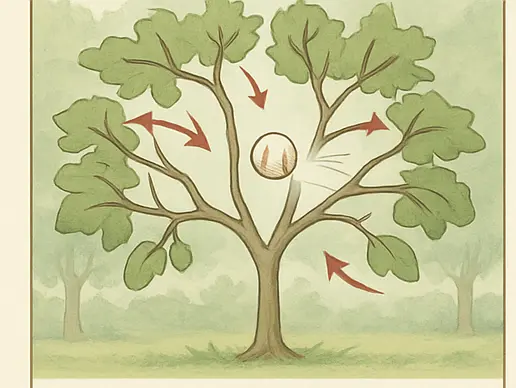
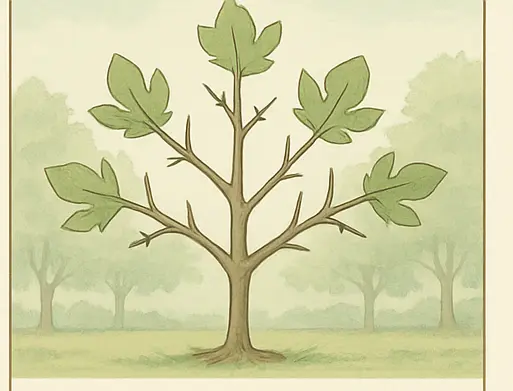
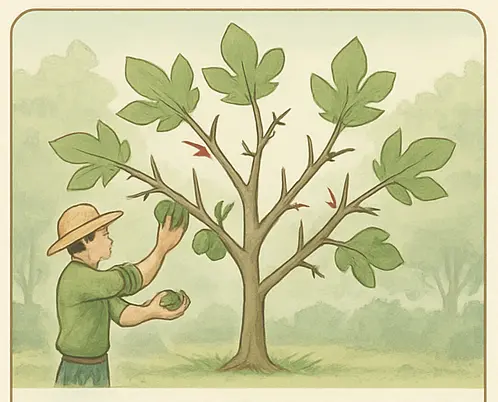
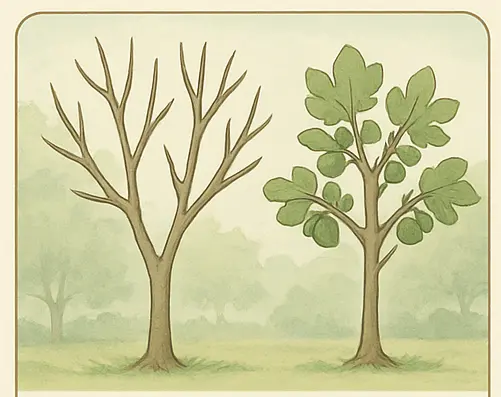
Special Considerations for Young vs. Mature Fig Trees
🪴 Young Trees (First 2–3 Years)
If you’ve just planted a fig tree, focus on training and structure, not fruit. Removing early figs will help the tree establish strong scaffolds.
- Encourage 3–5 well-placed main branches
- Remove low shoots and crowded growth
- Shorten first-year branches by about 50% to promote branching
🌳 Mature Trees (4+ Years)
For older trees, the goal is renewal and productivity. Thin the canopy yearly, control spread, and remove any non-productive wood.
- Thin canopy yearly to improve air and light flow
- Cut back long limbs to control spread
- If not pruned in years, spread corrective pruning over 2–3 seasons
Common Fig Tree Pruning Mistakes to Avoid
I have seen numerous pruning disasters over the years. Here are a few common ones:
- Pruning too early in winter – Cuts can dry out or get frost-damaged.
- Over-pruning all at once can stunt growth and reduce the fruit yield.
- Topping the tree – Never just “cut the top off”; it ruins natural form and invites disease.
- Ignoring tool hygiene – Spread one branch infection, and it could affect the whole tree.
- Cutting at random spots – Always prune to a node or branch collar.
From the Experts – When to Call a Professional
We encourage homeowners to roll up their sleeves and learn to care for their trees. However, if your fig tree is more than twelve feet tall, you have not pruned it in over five years, there is a complex branch structure, or you are simply not sure where to begin, it is worth giving us a call at Pro Tree Service Fremont. We offer expert pruning, health assessments, and cleanup so your fig tree stays healthy, productive, and beautiful.
Proper fig tree trimming is not just about aesthetics. It is about creating the right conditions for growth, fruiting, and long-term tree health. With the right approach, you can enjoy bountiful harvests and a beautiful tree for decades. Remember to prune during dormancy, use the right tools, shape gradually, and never be afraid to start small.
Need help or have questions? Our local Fremont team is just a call away. Let us keep your fig trees healthy.